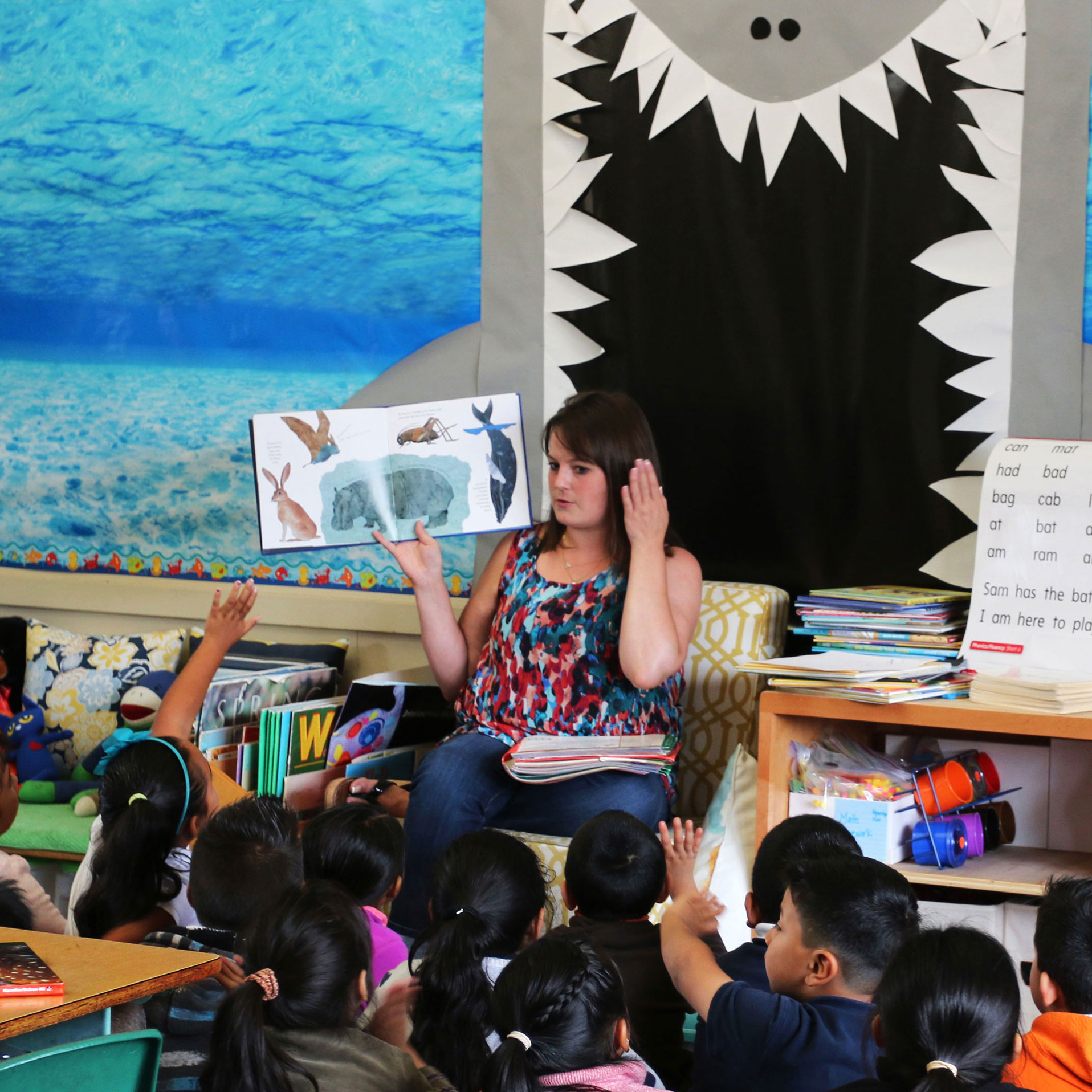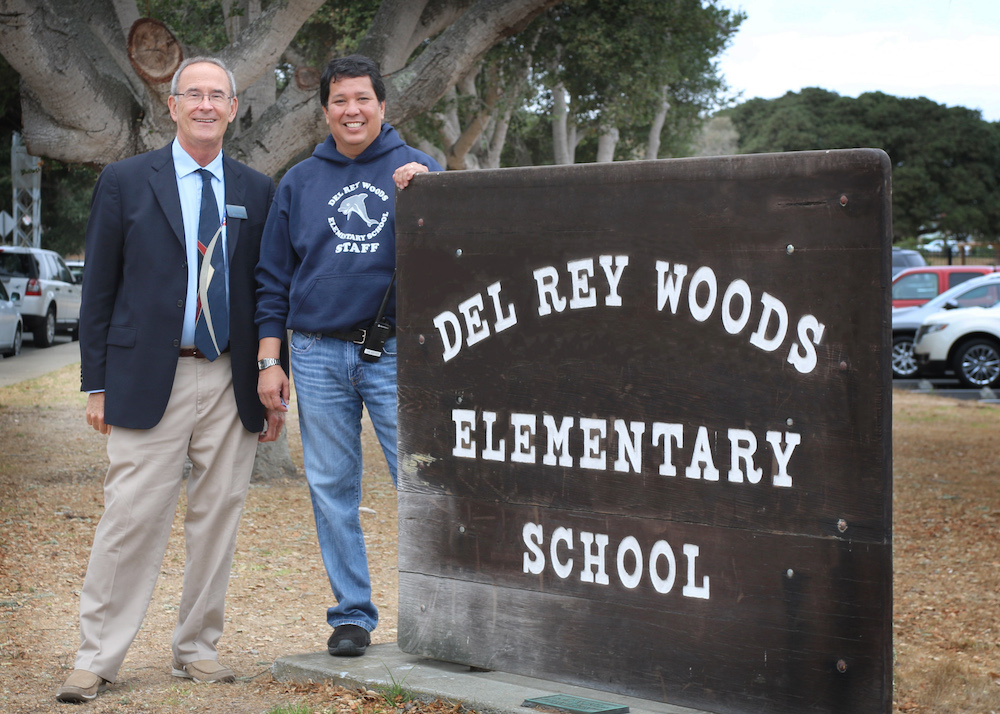CSUMB Magazine
Teach Now

First-grade teacher Theresa Ferrante had worked with plenty of student teachers from several colleges during her long career at Del Rey Woods Elementary School in Seaside. But eventually she decided to step away from the program.
“Then Marilyn Whitcomb (CSUMB teacher education instructor) approached me and said ‘Don’t you want to have a student teacher? It is different now.’ And I got back involved in it, and it has been great,” Ferrante said.
The difference is that Cal State Monterey Bay’s teacher preparation program now uses a co-teaching model, in which teaching candidates work with the professional teachers from before the first day of class.
CSUMB College of Education Dean Jose Luis Alvarado said, “One of the things that makes CSUMB unique is that we have a commitment from our district partners to allow our students to begin their activities at the beginning of the school year at the same time as their teachers. Most of the CSU campuses don’t do that.”
Active teaching
“We get our teacher candidates ready to teach children from the first day in the classroom forward,” said Mark O’Shea, professor of teacher education. “There is no back-seat observation, no extended period of passive presence in the classroom. They are actively teaching the children.”
That includes working with the teacher on setting up the classroom and planning the class, all the way through awarding the final grades.
The traditional model cast the teacher candidate more in the role of teacher’s aide, observing the classroom, working up to a period of solo teaching and then moving on.
Dr. O’Shea said CSUMB adopted the co-teaching model early, after sending personnel to San Diego to be trained on the new method.
“This is a much nicer blend, I think,” Ferrante said. “They (the student teachers) are here from the start of the year and they see the kids every day, or at least most days. It is nicer for the kids, it is nicer for the classroom teacher, because we have two adults providing the one-on-one that some students need.”
Dr. O’Shea said there is evidence that classrooms with co-teachers are seeing better standardized test scores.
“We are working on a model where we are adding value in the classroom, not asking the teacher to make a sacrifice to work with a student teacher— Mark O’Shea
Del Rey Woods Elementary was one of the first adopters of the new student teaching model. The principal is Rey Reyes.
“I wrote my dissertation on professional development in the schools, so it has always been an interest of mine. To help develop this and see the results has been really amazing,” said Reyes, now in his sixth year as principal.
Student teachers seeking an elementary credential spend two semesters at the school – one at a K-2 level classroom, the other at grade 3-5.
“We have been very fortunate. I work very closely with Diane Brandell (CSUMB teacher placement coordinator). She must give us the cream of the crop because the student teachers who come here have been really amazing,” Reyes said.
One of those CSUMB student teachers was Elyse Etcheverry.
Amazing experience
“I had a great experience here. I started in fourth grade, then I went to second grade with Theresa (Ferrante), who was amazing,” Etcheverry said.
Principal Reyes encouraged her to wait and see if a full-time job opened at Del Rey Woods.
“Five days before school started, he called me in and asked me if I wanted a job and I said, ‘yes please.’ So here I am,” said Etcheverry, who now teaches first grade and is in her third year of working full-time at the school.
Another of the benefits of the program for Del Rey Woods is that school personnel get a chance to see student teachers in action, and decide which ones would be the best fit for any openings. Five graduates of the CSUMB credential program now teach at Del Rey Woods.

“You can see really quickly, who has the gift to work with your age group. Within a week, you can see this person is meant for the little kids, and this person will stick with it,” Ferrante said.
And the student teachers aren’t just learning the basics.
“I always tell the student teachers, ‘You have an opportunity right now, if you want to try something new, do it in this class,’ ” Ferrante said. “ ‘There are two of us in this room. If you get hired, it is likely you will be the only teacher in that room, so here is an opportunity’.”
Teacher shortage
The need to educate excellent teaching candidates and to keep them in the classroom has never been more critical, as California and the nation as a whole face a severe teaching shortage.
Dr. O’Shea said the Great Recession forced a number of school districts to lay off teachers and raise class sizes. Reacting to that news, fewer and fewer students went into teacher education programs. Meanwhile, some older teachers stayed on the job and waited for their retirement accounts to recover.
Now the economy is bouncing back. More teachers are retiring. Districts are cutting class sizes. That adds up to a rising demand for teachers at a time when fewer students are pursuing those careers.
The Center for the Future of Teaching and Learning estimates that California will need an additional 100,000 teachers over the next decade.
“I really began to notice it during the 2013-14 academic year,” Dr. O’Shea said. “I visited teacher recruitment fairs. A lot of people were seeking teachers and people were not coming to their tables.
“It (the shortage) has moved from conventional areas such as math and science, into other areas. A typical area that has had a surplus was social studies. However, for the past couple of years we have had no trouble getting jobs for all of our social studies teachers.”
In response to the teaching shortage, the California Legislature is considering a number of bills, including one that would fund co-teaching programs like CSUMB’s in low-income schools.
Support
Another aspect of the problem, Dr. O’Shea said, is that half of new teachers nationwide leave the classroom within five years. A benefit of the co-teaching model, especially for new teachers who get jobs in the same districts where they were student teachers, is that they have a built-in support system to help them succeed.
“Starting a new job, you have to get to know the school atmosphere, get to know the teachers, get to know the kids. If they get hired in the same place, the stress level is on the academic part of it, not all the other issues,” Ferrante said.
Etcheverry said her former supervising teachers are “genuinely friends, as well as a wealth of knowledge for me to use.”
This semester, Ferrante’s student teacher from CSUMB is Haley Kostas. Kostas said she talks with friends who are in student teacher programs at other colleges who don’t have the chance for such extensive classroom experience.
“I would have not felt confident after just one semester (of student teaching). I think I really needed this extra time. I think it makes better teachers and it takes away some of the struggles of the first year. I am sure they still will be there, but I am not as nervous about it as I would have been,” Kostas said.
For the record, Ferrante said Kostas should have no problem finding a job.